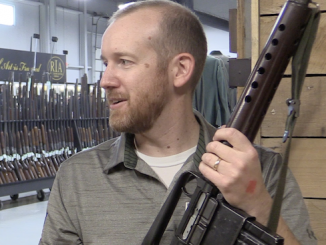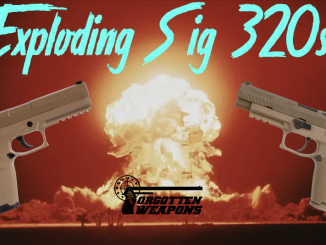The model of 1885 (a modern collector designation; Remington called these the “Remington Magazine Rifle” and did not differentiate between the different versions) was the final iteration of James Paris Lee’s bolt action rifle made by Remington. It incorporated a number of improvements from the earlier versions, including a relocated bolt handle, improved bolt head, and a magazine that could now hold cartridges securely without the use of a sliding catch at the nose.
These rifles were made in .45-70 caliber for US use and in .43 Spanish for export sales. The US Navy purchased most of the .45-70 guns that were made, and this particular rifle is one of those Navy guns. By the time these rifles were actually in production, Great Britain had also decided to adopt the Lee system in 1888, which would go through several iterations and ultimately become the iconic SMLE that would be the mainstay of British infantry during the First World War.




Nice one, as usual! Could you slow down the first close up shots of all these videos (around 1:15 – 1:30) and film these a bit futher away?
As usual, most great ideas in American arms development in the late 19th Century seem to have needed to go to customers abroad in order to prove themselves worthy of adoption in their home country. When did the “moss backs” stop being the major influence in the Ordinance Board?
Other nations also has their objections when were adopting new repeating rifle, for example magazine cut-off device were requested.
“When did the “moss backs” stop being the major influence in the Ordinance Board?”
Ordnance Boards are always well ready for PREVIOUS war, sadly it can be sometimes also applied to high-ranked commanders.
Alexander Rose, _American Rifle: A Biography_ (NY: Delacorte, 2008), 262-3: The Krag was the “ancien régime” based on seniority. The M1903 was the post Adelbert Buffington “modern and au courant du jour” Ordnance Dept. based on merit.
Please correct me if I’m mistaken: In the case of the Remington-Lee Navy rifle, the elegantly simple “magazine cut off” mechanism to hold the magazine “in reserve” while the arm was operated as a single-shot rifle was a “half-way” catch on the box magazine? Yes?
Thus, the magazine was held securely, but too low to feed cartridges into the bolt raceway, and when a repeater was necessary, it was simply moved up to the second magazine catch.
A neat gun! A bit of a mystery that the U.S. Ordnance selected the “foreign” Krag-Jørgensen while the Brits adopted the Scottish American Lee, no?
Well, Dave, I don’t really know abut that, but the magazine cutoff seems useful only for training purposes. First get your recruits to actually hit something with a single shot (you shouldn’t have them shoot sitting bull’s eyes all the time, so I’d recommend hiding that bull’s eye behind rocks and foliage in later courses). Then have the pupils load the magazine and use it for shooting at multiple targets or shooting at moving targets while under stress (suppressive fire before the day of the automatic machine gun or countering ambushes). Individual marksmanship will be considered for designated squad marksmen or dedicated snipers…
The “magazine cutoff” on the SMLE MK 3 0.303in I had as a boy was a triangular piece of steel with a pivot at the narrow “tip” and a thumbpiece, that rotated in and out of a slot on the right side of the receiver just below the bolt.
When it was “in”, it blocked the top round in the magazine from rising far enough to be picked up by the bolt, as well as acting as a “loading shelf” for reloading the rifle one-at-a-time by hand; just drop a round in, bolt the rifle, done, ready to fire.
Pulling it out to the right on its pivot moved it out of the way of the magazine’s double column of cartridges and allowed the rifle to feed from the magazine normally.
This handy item was left off of most later iterations of the SMLE; IIRC the half-breed No 1 Mk 5 (1920) was the last to have one, although the Mk 3* (3 Jan 1916) was the first to omit it, in the name of faster mass-production. No Rifle No. 4 variant had it, AFAIK.
It can easily be “spotted”. Just look for a small cylindrical steel piece with a thumb-grooved top atop the stock wood on the right side of the receiver, just below the bolt opening and almost exactly centered over the side of the magazine, front to back.
cheers
eon
A bit of a mystery that the U.S. Ordnance selected the “foreign” Krag-Jørgensen while the Brits adopted the Scottish American Lee, no?
The British testing commission was very impressed both with M Rubin’s results with 7.7mm bullets at high velocity (for those days) and with his rifle.
7.7mm calibre was there to stay (.303)
It was only later during the trials that it emerged that the Lee had a more durable bolt design than the Rubin design, and the Lee bolt was adopted for further development.
The Lee magazine was also not necessarily certain from the start that Lee’s box magazine would be selected. The Pattern Room collection also has rifles with three lug Lee style bolts, and Bethel-Burton, hopper feed systems.
The best refs I’ve seen on this were Skennerton’s.
The British military at the time, was still fighting with massed soldiers, drilled in volley fire.
The soldiers were neither trained in marksmanship, nor were they trusted to choose when to fire. And in both Britain and America (remember that the 03 Springfield has a magazine cut off) it was assumed that if ordinary soldiers had a magazine full of ammunition, they just waste it.
Britain had not fought a developed World foe, probably since 1815.
The “Boer Wars” were a very rude awakening. Afrikaans, discovered at Spion Kopje, that once the British Ruperts were shot (a relatively simple task for a guys used to using cover, stalking game, estimating range in their home environment and doping the wind), the ordinary troops did not know what to do, and could be dealt with at leisure.
America had a similar rude awakening during the “liberation” of Cuba.
In both instances, the weapons they were facing were Mausers, which were specifically set up to discourage single loading.
Mauser’s extractors for his smokeless powder rifle actions (certainly from 1894) were angled to make it almost impossible to snap over a round which came by any route that wasn’t the magazine. Even later extractors for the German Gew 88 (commission rifle) were set up with a cut away bolt rim for controlled feeding from the magazine.
During WW1, the hole in the ribbed tubular grip for the SMLE’s mag cut off became the subject for German propaganda.
The Brits certainly were the masters of propaganda in that war (lurid tales of invading German soldiers passing Belgian infants from bayonet to bayonet, as a game).
The German propagandists reported that the hole in the cutoff was to allow the Brits to snap the aluminium noses from their bullets in order to make dum dums – forbidden by international treaty from being used against white men…
I’d love to see one of those Remmington Lee actions out of its stock.
I know that there is a good chance that its simple cylindrical form with relatively few milling cuts, might be messed up by a recoil lug, or a big milled from solid surround for a magazine box…
but from the top, that receiver looks like a masterpiece of styling with absolutely minimal machining.
OMG, did the British authorities mess that up, in the name of economising on left over martini henry woodwork! and in the process ended up with some of the most fickle rifles to bed and to keep bedded.
I look at pictures of Lee Enfield No1 and No4 military actions and Lee-Speed sporter actions, and I haven’t got the faintest clue how they were machined.
Colvin and Viall describe in great detail how the 03 Springfield was manufactured, and Lindsey, re-set and re published articles from machinery magazine on the manufacture of the straight pull Lee Navy (its a bit thin on detail), and the Canadian Ross rifles. but I’ve still to find details on how many resources were wasted on the grossly over complex machining of the British Lee actions.
Was the M1885 used in any capacity and numbers by the US Marine Corps?